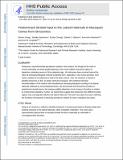Predominant Striatal Input to the Lateral Habenula in Macaques Comes from Striosomes
Author(s)
Hong, Simon; Amemori, Satoko; Chung, Emily; Gibson, Daniel J.; Amemori, Ken-ichi; Graybiel, Ann M.; ... Show more Show less
DownloadAccepted version (1.564Mb)
Terms of use
Metadata
Show full item recordAbstract
Striosomes, neurochemically specialized modules in the striatum, are thought to be nodes in circuits extending, via basal ganglia pathways, from mood-related neocortical regions to dopamine-containing neurons of the substantia nigra. Yet striosomes have remained beyond the reach of electrophysiological methods to identify them, especially in non-human primates. Such work is needed for translational as well as for basic science. Here we introduce a method to identify striosomes on-line in awake, behaving macaques. We combined electrical microstimulation of the striatum with simultaneous electrophysiological recording in the lateral habenula (LHb) followed by immunohistochemistry. We demonstrate that striosomes provide the predominant striatal input to the macaque pallido-habenular circuit, which is known to function in relation to reinforcement signaling. Further, our experiments suggest that striosomes from different striatal regions may convergently influence the lateral habenula. This work now opens the way to defining the functions of striosomes in behaving primates in relation to mood, motivation, and action. Keywords: basal ganglia; dopamine; motivation; non-human primate; mood; learning; microstimulation
Date issued
2018-12Department
McGovern Institute for Brain Research at MIT; Massachusetts Institute of Technology. Department of Brain and Cognitive SciencesJournal
Current Biology
Publisher
Elsevier BV
Citation
Hong, Simon et al. "Predominant Striatal Input to the Lateral Habenula in Macaques Comes from Striosomes." Current biology 9, 1 (January 2019): 51-61 © 2018 Elsevier Ltd
Version: Author's final manuscript
ISSN
0960-9822